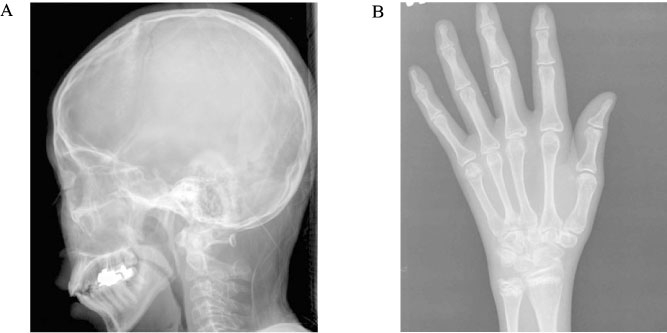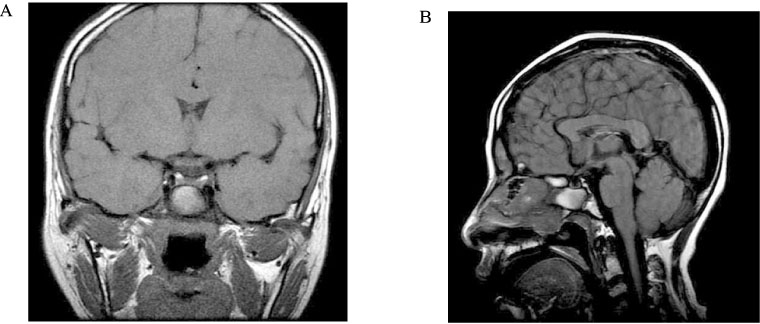J Korean Endocr Soc.
2007 Aug;22(4):272-276. 10.3803/jkes.2007.22.4.272.
A Case of Idiopathic Central Diabetes Insipidus together with Primary Empty Sella and Combined Pituitary Hormone Deficiency
- Affiliations
-
- 1Department of Internal Medicine, Catholic University of Daegu School of Medicine.
- KMID: 2063537
- DOI: http://doi.org/10.3803/jkes.2007.22.4.272
Abstract
- Central diabetes insipidus is a heterogeneous condition that is characterized by polyuria and polydipsia, and this is due to a deficiency of arginine vasopressin. Central diabetes insipidus is rare in children and young adults, and up to 50 percent of cases are idiopathic. Genetic abnormalities in the homeobox genes have recently been shown, on sellar magnetic resonance imaging, to be associated with combined pituitary hormone deficiency with pituitary defect. We report here on a 44-year-old female who suffered from polydipsia, polyuria and primary amenorrhea since childhood. She was diagnosed with idiopathic central diabetes insipidus together with primary empty sella and combined pituitary hormone deficiency. On the genetic analysis, she was proven to have a point mutation of the PROP-1 gene, which is known as a cause of combined pituitary hormone deficiency.
MeSH Terms
Figure
Reference
-
1. Maghnie M, Cosi G, Genovese E, Manca-Bitti ML, Cohen A, Zecca S, Tinelli C, Gallucci M, Bernasconi S, Boscherini B, Severi F, Arico M. Central diabetes insipidus in children and young adults. N Engl J Med. 2000. 343:998–1007.2. Mootha SL, Barkovich AJ, Grumbach MM, Edwards MS, Gitelman SE, Kaplan SL, Conte FA. Idiopathic hypothalamic diabetes insipidus, pituitary stalk thickening, and the occult intracranial germinoma in children and adolescents. J Clin Endocrinol Metab. 1997. 82:1362–1367.3. Greger NG, Kirkland RT, Clayton GW, Kirkland JL. Central diabetes insipidus. 22 years' experience. Am J Dis Child. 1986. 140:551–554.4. Jeon HJ, Park SH, Kwon SH, Lee SH, Park KS, Kim SY, Lee HK. Clinical Course of Idiopathic Central Diabetes Insipidus in Adults. J Kor Soc Endocrinol. 2001. 16:190–198.5. Brooks BS, el Gammal T, Allison JD, Hoffman WH. Frequency and variation of the posterior pituitary bright signal on MR images. AJR Am J Roentgenol. 1989. 153:1033–1038.6. Tien R, Kucharczyk J, Kucharczyk W. MR imaging of the brain in patients with diabetes insipidus. Am J Neuroradiol. 1991. 12:533–542.7. Kim SS, Kim YH, Shin YL, Kim GH, Kim TU, Yoo HW. Clinical characteristics and molecular analysis of PIT1, PROP1, LHX3, and HESX1 in combined pituitary hormone deficiency patients with abnormal pituitary MR imaging. Horm Res. 2003. 60:277–283.8. Matisonn R, Pimston B. Diabetes insipidus associated with empty sella turcica. Postgrad Med J. 1973. 49:274–276.9. Chung JH, Lee EJ, Chung YS, Whang ES, Ahn KJ, Lim SK, Kim KR, Lee HC, Huh KB. Empty Sella Syndrome Associated with Diabetes Insipidus: Report of Two Cases. J Kor Soc Endocrinol. 1992. 7:66–70.10. Kim ES, Kim IJ, Moon YJ, Na SK, Nam SY, Lee EJ, Kim KR, Song YD, Lim SK, Lee HC, Huh KB. Primary Empty Sella Syndrome -Clinical and Endocrinologic Evaluation-. J Kor Soc Endocrinol. 1997. 12:386–392.11. Blotner H. Primary or idiopathic diabetes insipidus: a system disease. Metabolism. 1958. 17:191–200.12. Kim BC, Lee MY, Kim YK, Lee OJ, Koong SS, Oh TK. A case of langerhans cell histiocytosis presented with central diabetes insipidus. J Kor Endocrine Soc. 2005. 20:513–518.13. De Marinis L, Bonadonna S, Bianchi A, Maira G, Giustina A. Primary Empty Sella. J Clin Endocrinol Metab. 2005. 90:5471–5477.14. Lopez-Bermejo A, Buckway CK, Rosenfeld RG. Genetic defects of the growth hormone-insulin-like growth factor axis. Trends Endocrinol Metab. 2000. 11:39–49.15. Mullis PE. Transcription factors in pituitary gland development and their clinical impact on phenotype. Horm Res. 2000. 54:107–119.16. Netchine I, Sobrier M-L, Krude H, Schnabel D, Maghnie M, Marcos E, Duriez B, Cacheux V, Moers A, Grossens M, Gruters A, Amselem S. Mutations in LHX3 result in a new syndrome revealed by combined pituitary hormone deficiency. Nat Genet. 2000. 25:182–186.17. Dattani MT, Martinez-Barbera JP, Thomas PQ, Brickman JM, Grupta R, Martensson IL, Toresson H, Fox M, Wales JK, Hindmarsh PC, Krauss S, Beddington RS, Robinson IC. Mutations in the homeobox gene HESX1/Hesx1 associated with septo-optic dysplasia in human and mouse. Nat Genet. 1998. 19:125–133.
- Full Text Links
- Actions
-
Cited
- CITED
-
- Close
- Share
- Similar articles
-
- A Case of Primary Empty Sella Syndrome with Central Diabetes Insipidus
- A Case of Central Diabetes Insipidus with Growth Hormone Deficiency and Loss of Hyperintense Signal in the Posterior Lobe
- A Case of Teratocarcinoma with Central Diabetes Insipidus
- A case of primary empty sella syndrome combined with Cushing's disease
- Central Diabetes Insipidus Associated with a Pituitary Tumor



